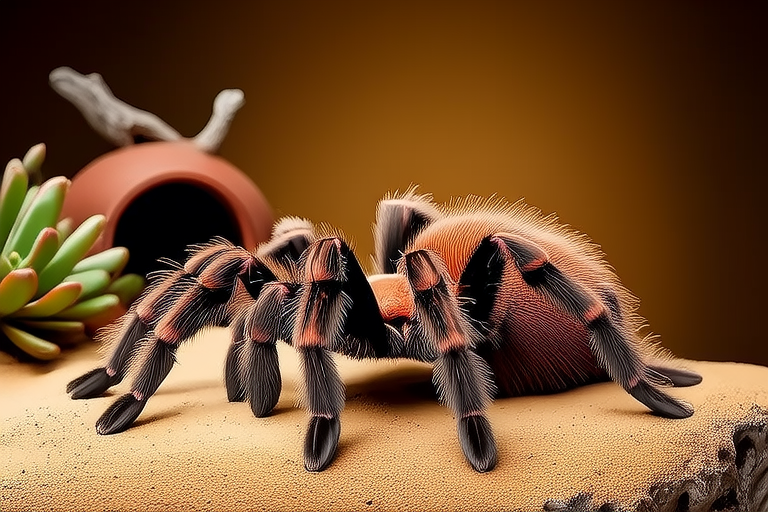The Ultimate Guide to Choosing the Perfect Habitat for Your Chilean Rose Tarantula
Chilean Rose Tarantulas (Grammostola rosea) are popular pets among arachnid enthusiasts due to their docile nature and relatively low maintenance requirements. However, providing them with an optimal habitat is crucial for their health and well-being. This guide will walk you through everything you need to know about creating the perfect environment for your Chilean Rose Tarantula.
Enclosure Size Based on Tarantula Age
The ideal enclosure size varies depending on the age and size of your tarantula. Younger tarantulas require smaller enclosures because they grow quickly. As they mature, you can gradually increase the size of their enclosure. Here’s a general guideline:
- Newborn to Juvenile (Up to 1 Year): A 5-gallon tank or equivalent space.
- Subadult (1-3 Years): A 10-gallon tank or equivalent space.
- Adult (3+ Years): A 20-gallon tank or equivalent space.
Remember, larger enclosures provide more space for exercise and exploration, which helps maintain your tarantula’s overall health.
Necessary Substrate Types and Depth
The substrate serves as bedding for your tarantula and helps regulate humidity within the enclosure. For Chilean Rose Tarantulas, coconut fiber, peat moss, or vermiculite work best. These materials retain moisture well but still allow for proper drainage.
Depth of substrate depends on the tarantula’s stage of life:
- Newborn to Juvenile: 2 inches deep.
- Subadult: 3-4 inches deep.
- Adult: 4-6 inches deep.
Adequate depth allows for burrowing behavior, which is essential for these tarantulas. Make sure to keep the substrate moist but not wet to prevent mold growth.
Appropriate Temperature and Humidity Levels
Maintaining the right temperature and humidity levels is vital for your tarantula’s health. The ideal range for Chilean Rose Tarantulas is:
- Temperature: 78-85°F (25-29°C).
- Humidity: 50-70%.
To achieve these conditions, you may need to use a combination of heating pads, heat lamps, and misting systems. Always monitor these levels closely using thermometers and hygrometers placed at different points within the enclosure.
Recommended Hiding Spots and Decorations
Hiding spots are essential for providing security and reducing stress. Cork bark tubes, half logs, or plastic plants make excellent hiding spots. Place these items on top of the substrate rather than burying them, as this encourages natural digging behavior.
Adding decorations like small rocks or branches can create a more stimulating environment while also offering additional climbing opportunities. Ensure all decorations are securely fastened to prevent accidental injuries.
Ventilation Requirements
Proper ventilation ensures fresh air circulation within the enclosure, preventing stagnant conditions that could lead to respiratory issues. Screen tops or mesh lids work well for maintaining airflow without allowing escape. Avoid using glass lids unless paired with adequate ventilation holes.
Lighting Needs
Chilean Rose Tarantulas are nocturnal creatures, so they don’t require direct light exposure. Instead, provide a dim red or blue bulb if you want to observe them during feeding times. Never use white lights, as they can cause stress and disrupt their natural sleep patterns.
Cleaning Schedules
Regular cleaning helps maintain hygiene and prevents disease. Here’s a suggested schedule:
- Daily: Remove any uneaten prey items.
- Weekly: Spot clean the substrate by removing waste and replacing it with fresh material.
- Monthly: Deep clean the entire enclosure, including replacing all substrate and disinfecting surfaces with pet-safe cleaners.
Always wash your hands before and after handling your tarantula or its enclosure to avoid transferring harmful bacteria.
Tips for Setting Up a Safe and Stimulating Environment
Creating a safe and stimulating environment involves several considerations beyond just physical setup. Here are some additional tips:
- Environmental Enrichment: Introduce new objects periodically to keep your tarantula engaged. Rotate items every few weeks to encourage exploration.
- Feeding: Feed your tarantula appropriately sized insects such as crickets, mealworms, or dubia roaches. Offer food every 1-2 weeks depending on its appetite.
- Handling: Handle your tarantula gently and infrequently. Frequent handling can cause unnecessary stress and potential injury.
- Monitoring Health: Regularly check for signs of illness such as lethargy, loss of appetite, or abnormal behavior. Consult a veterinarian specializing in exotic animals if you notice any concerning symptoms.
By following these guidelines, you’ll be able to create a thriving home for your Chilean Rose Tarantula that closely resembles its natural habitat.
